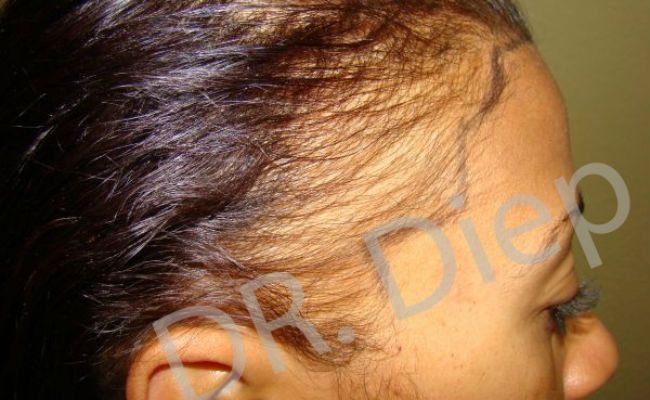The patterns of hair loss in women are not as easily recognizable as those in men.
Unlike hair loss in men, female hair loss may commonly begin at any age through 50 or later, may not have any obvious hereditary association, and may not occur in a recognizable “female-pattern alopecia” of diffuse thinning over the top of the scalp.
A woman who notices the beginning of hair loss may not be sure if the loss is going to be temporary or permanent. For example, if there has been a recent event such as pregnancy or illness, this may be the reason for temporary hair thinning. Women tend to have less obvious patterns of hair loss than men, and non-pattern types of hair loss are more frequent in women than in men, according to Dr. Diep at Medical Hair Transplant And Aesthetics in San Francisco. Diagnosis of hair loss in a woman should be made by a trained and experienced physician.
Androgenetic Alopecia
In women as in men, the most likely cause of scalp hair loss is androgenetic alopecia, an inherited sensitivity to the effects of androgens (male hormones”> on scalp hair follicles. However, women rarely develop the “cue-ball” appearance often seen in male-pattern androgenetic alopecia.
Patterns of female androgenetic alopecia can vary considerably in appearance and include:
- Diffuse thinning of hair over the entire scalp, often with more noticeable thinning toward the back of the scalp.
- Diffuse thinning over the entire scalp, with more noticeable thinning toward the front of the scalp but not involving the frontal hairline.
- Diffuse thinning over the entire scalp, with more noticeable thinning toward the front of the scalp, involving and sometimes breaching the frontal hairline.
Unlike the case for men, thinning scalp hair in women due to androgenetic alopecia does not uniformly grow smaller in diameter (miniaturize”>. Women with hair loss due to androgenetic alopecia tend to have miniaturizing hairs of variable diameter over all affected areas of the scalp.
While miniaturizing hairs are a feature of androgenetic alopecia, miniaturization may also be associated with other causes and is not in itself a diagnostic feature of androgenetic alopecia.
In postmenopausal women, hair may begin to miniaturize and become difficult to style. The precise diagnosis should be made by a physician hair restoration specialist. If left untreated, this hair loss associated with early puberty can progress to more advanced loss.
Non-Pattern Causes of Female Hair Loss
Trichotillomania is compulsive hair pulling. Hair loss due to trichotillomania is typically patchy, as compulsive hair pullers tend to concentrate the pulling in selected areas. Hair loss due to this cause cannot be treated effectively until the psychological or emotional reasons for trichotillomania are effectively addressed.
Alopecia areata is a possibly autoimmune disorder that causes patchy hair loss that can range from diffuse thinning to extensive areas of baldness with “islands” of retained hair. Medical examination is necessary to establish a diagnosis.
Triangular alopecia loss of hair in the temporal areas sometimes begins in childhood. Hair loss may be complete, or a few fine, thin-diameter hairs may remain. The cause of triangular alopecia is not known, but the condition can be treated medically or surgically.
Scarring alopecia hair loss due to scarring of the scalp area. Scarring alopecia typically involves the top of the scalp and occurs predominantly in women. The condition frequently occurs in African-American women and is believed to be associated with persistent tight braiding or “corn-rowing” of scalp hair. A form of scarring alopecia also may occur in postmenopausal women, associated with inflammation of hair follicles and subsequent scarring.
Telogen effluvium is a common type of hair loss caused when a large percentage of scalp hairs are shifted into “shedding” phase. The causes of telogen effluvium may be hormonal, nutritional, drug-associated, or stress-associated. Loose-anagen syndrome—a condition occurring primarily in fair-haired persons in which scalp hair sits loosely in hair follicles and is easily extracted by combing or pulling. The condition may appear in childhood, and may improve as the person ages.
Diagnosis and Treatment
If you are a woman with thinning or lost scalp hair, your first necessary step is to have the condition correctly diagnosed by a physician hair restoration specialist. After a diagnosis is made, the physician will recommend an approach to effective medical or surgical treatment.
This has been updated for clarity and timeliness. Reprinted with permission from the International Society of Hair Restoration Surgery. For more information, please visit www.ISHRS.org



